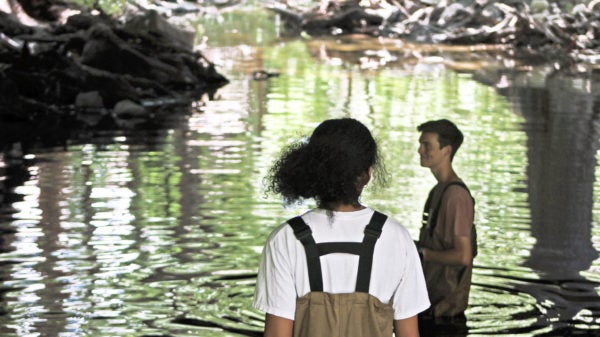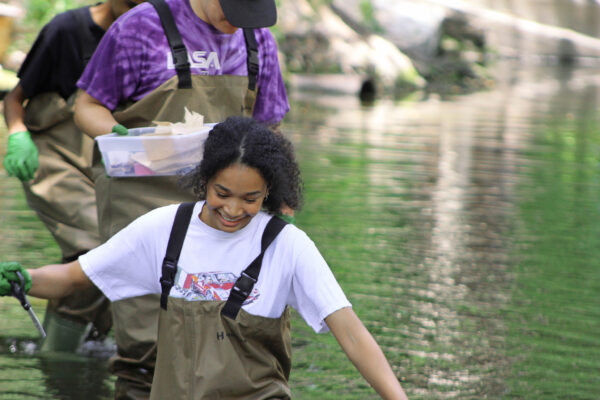On a muggy summer day, a local high school student is kneeling on shallow rocks, with legs safely tucked into waders and rubber boots as he gathers samples from the urban stream that flows through campus. He wiggles a square net into the mud to collect larvae that act as sensors of Waller Creek’s water quality. Upstream, another student perches near a fossilized mollusk to conduct a chemistry experiment that will shine a light on hidden phosphates and nitrates. The rest of the team fills out the same form used by city ecologists to assess local habitat. They are standing under a hackberry with a history of flash floods and destabilized banks written in the arc of its trunk.
These high school students from across Austin are spending their summer on campus getting their feet wet exploring a future in science with the Urban Ecosystems research group.
This is the third summer that about 45 students have suited up to take measure of Waller and other creeks, and about 15 returning members help lead the research — research that continues during the school year with incoming freshmen who participate in the College of Natural Sciences’ Freshman Research Initiative.
“Urban Ecosystems uses the city as a living lab, immersing students in real-world, publishable research to help understand resiliency of our environment,” says Mary Poteet, an assistant professor of practice in the Jackson School of Geosciences and one of the three faculty leaders of this research group. “By evaluating the ecosystem of Waller and other creeks, students directly measure resilience and sustainability in this ecosystem, which is new for both restoration efforts and for Central Texas.”
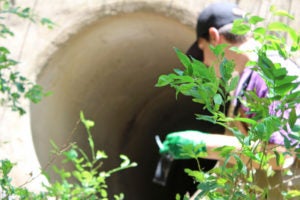
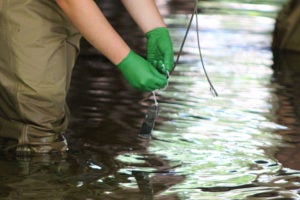
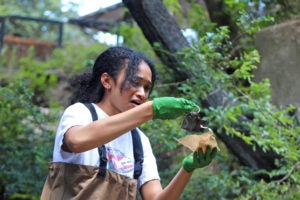
In Painter Hall, the teams work at newly renovated blacktop research benches. Above are shelves lined with beakers and labeled chemicals, and a rubber duck wearing safety glasses watches over them. Hunched over microscopes and referencing “Aquatic Insects of North America,” students think that they have discovered a new damselfly nymph, adding to the approximately 250 species identified to date.
Scout, a high school student who returned to the program this summer as a leader, mentions that his team found a water penny in a creek across town. When another student asks what that is, he quips, “Like a sand dollar but costs less.”
Stuart Reichler, another faculty leader for this research group, is watching the exchange and barks a benevolent laugh. “How long have you been waiting to say that one?”
Poteet, Reichler and their colleague, Ruth Shear, have developed a comprehensive series of experiments to answer research questions about water quality. As Reichler says, Waller Creek is a poster child for an urbanized creek.
“But I think that Waller is more than a storm water and sewage dump,” continues Reichler. “This project exposes students to the idea that city nature has value and that there are beautiful places that we need to protect.”
This project exposes students to the idea that city nature has value and that there are beautiful places that we need to protect.”
Each day, students fan out from the lab to collect samples for various projects. Others feed samples into an array of analytical instruments to test for heavy metals, antibiotics, polycyclic aromatic hydrocarbons, and pesticides.
Another study uses a more environmentally friendly version of an old way to search for infrastructure leaks: Instead of dumping large quantities of dye into sewer lines for waiting volunteers spot as it leaks into the creek, a student team crawled through the bowels of buildings to add tiny amounts of fluorescing yellow dye to the sump systems. Because this dye binds to strategically placed charcoal-filled bags, students can return to the lab and look for faint signals that highlight the leakage of sewage, with only minimal dye contamination of the creek water. Yet another group taught by Tim Riedel, faculty lead of the DIY Diagnostics research group, is designing and building environmental sensors. For example, they recently developed a 3D-printed water flow meter for $40 — which is cheaper than the $1,000-plus scientific machine and much more accessible to anyone interested in environmental quality.
“Because of the interdisciplinary nature of our research, bringing biology, ecology and chemistry together, we solve problems that we cannot solve on our own,” says Shear, a faculty member in the Department of Chemistry. “This helps students see what environmental scientists do.”
